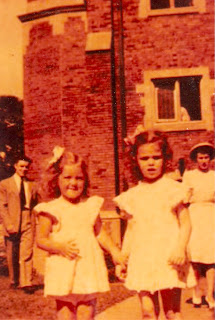

This small carpenter-built Queen Anne cottage has stood at 76 North Ritter since the late nineteenth century. A modest home with six rooms, the structure has served as a dwelling for dozens of Irvington families over the years. In 1910, telephone inspector Alfred S. Barnett and his family lived in the small home. Other families who resided here included the Williams, Schafers, Davenports, Wengers, Cases, Porters, Marquettes, and Rodenbecks. The Howell family, who lived in the cottage throughout the 1960s, 70s, 80s, and 90s stayed the longest.
The older photo is a scanned copy of a letter sent from Peter Wenger to Martha Scott in 1985. In the letter Mr. Wenger, who lived in the house as a boy from 1920 to 1925, jokingly wrote, "And you thought Abe Lincoln came from a humble abode. At least he got a monument, which I am still waiting for." His correspondence is filled with references to his friends along Ritter Avenue including the Campbell (72 North Ritter Avenue) and Elrod children.
The Wengers attended a morning kindergarten located at 18 North Ritter Avenue (demolished) run by Gail Baker. Harry and his best friend "Boy" Campbell used to camp out in the shed in the backyard with the Campbell collie for protection. Harry's mother, in a moment of compassion, occasionally asked her two sons to spend the night across the street as the elderly widow who lived there was afraid at night. He wrote about this years later, "We would get in our PJs and cross the street to go to bed. Neither of us liked doing this." In 1925, the Wengers moved to Oakland, California.
The historic image was taken on July 19, 1920. The children pictured are Genevieve Campbell, Jack Sewatz, Harry Wenger, Jr., Jim Wenger, and Max Taylor. The barn is no longer standing. The Victorian porch has also been removed.
The contemporary photo was taken in the early spring of 2011.











